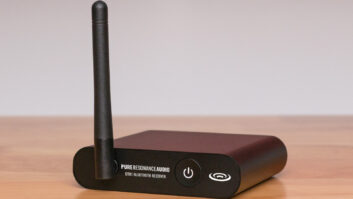
NFL Films crew members Kyle Hartigan (left) and Scott Carter display Lectrosonics SMD transmitters.
The audio technicians at NFL Films are using Lectrosonics SMD transmitters to capture on-field audio for televised NFL games. NFL Films is a full-service production and post-production company housed under one roof. NFL Films has its own camera and sound departments for location work, as well as film processing labs, recording studios, on-staff composers, lighting directors and more.
NFL Films also produces sports-related programming. In association with HBO Sports, the company produces the show Hard Knocks: Training Camp with the Kansas City Chiefs, which debuted in August.
According to Jerry Mahler, NFL Film’s executive in charge of audio and music, “NFL Films has been capturing on-field audio for quite some time, and over the years, we’ve encountered every type of failure you can imagine. We’ve worked with a lot of equipment, but nothing has the sound quality, durability and reliability that Lectrosonics equipment offers. For the past several months, we’ve been using the Lectrosonics SMD transmitters with the RM remote control and they’ve been terrific.”

Lectrosonics SMD transmitter
For capturing on-field audio, the transmitters are routinely placed into a recessed area of the player’s shoulder pads. Cable ties are used to secure the transmitter into place, and the unit is then covered with foot foam in order to ensure a lump-free installation. Additionally, a custom-made metal plate covering the transmitter, antenna and microphone connections is placed over the system to provide additional protection. The mic cable is taped all along the back of the shoulder pads, concealed between the soft and hard shells.
“There can’t be any bulges,” says Mahler, “because that would only make the equipment more vulnerable, and player safety is of paramount concern. The opponent must not be able to grab the transmitter, as could possibly happen when a player is tackled by grabbing the collar. We also make certain the mic is facing down. This way, if a player gets doused with water, the capsule doesn’t get destroyed.”
Mahler reports that the dual battery found in the SMD transmitters, in conjunction with the system’s remote capabilities, work well for this application. “We typically get the shoulder pads four to five hours prior to game time,” he says. “While we obtain the player’s approval, we get the shoulder pads from the team’s equipment manager and prepare the setup prior to the team’s arrival, so the added battery life of the SMD is very important. We’ve also been particularly impressed with the ability to remotely control the SMDs with the available RM remote. Now, we can change audio input gain and frequency settings without having to bother the player. This is a real lifesaver. Because of the way the transmitter is placed into the shoulder pads, making these adjustments without the remote capability would be a serious hindrance. We first used the remotes during this year’s Super Bowl game, and they worked really well for us.”
As part of the RM remote’s capabilities, the system can also lock and unlock the transmitter’s front panel controls, and enable/disable sleep mode. Because the RM’s operation is acoustic, and not infrared, a direct line of sight is not required.
Currently, NFL Films uses in excess of 20 systems. “Our SMDs are mated with the Lectrosonics Venue receiver systems—both the VR and VR Field models—and we use the company’s LecNet2 software to configure the equipment,” Mahler concludes.
For more information, visit www.lectrosonics.com and www.nflfilms.com.







